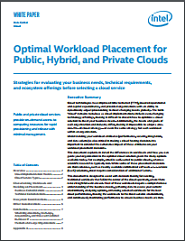Optimal Workload Placement for Public, Hybrid, and Private Clouds

Cloud technologies have improved time to market (TTM), lowered operational and capital expenditures, and provided organizations with an ability to dynamically adjust provisioning to meet changing needs globally. The term “cloud” remains nebulous as cloud implementations include ever-changing technology offerings, making it difficult to discern how to optimize a cloud solution to meet your business needs. Additionally, the needs and goals of each organization and industry differ, making it impossible to adopt a one-size-fits-all cloud strategy or even the same strategy for each workload within an organization.
Understanding your workload attributes (performance, security, integration, and data volume) is also critical in making a cloud hosting decision. It is important to consider the cumulative impact of these attributes on your workload placement decisions.
This document explains in detail the differences in workloads and how you can guide your organization to the optimal cloud solution given the many options available today. For example, email is well-suited to public clouds, whereas scientific research is typically not. While some of these placement decisions are more obvious, such as readily available commercial software-as-a-service (SaaS) solutions, most require consideration of additional factors.
This document is designed to assist with decision making for existing, traditional workloads that fall in the center of the cloud spectrum, where there is no straightforward answer. Most of these workloads require a comprehensive understanding of the business needs, gathering data to assess your current environment, analyzing options, enhancing selected workloads for the best cloud performance, moving the workloads to the most suitable environment, and continuously monitoring performance to ensure business needs are met.


